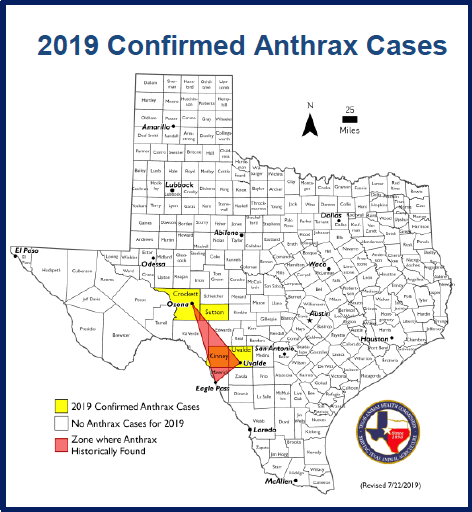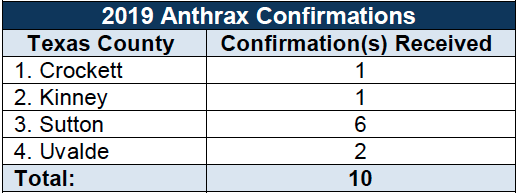Source: Texas Animal Health Commission | July 22, 2019
Since the July 16, 2019, update, anthrax has been detected on 1 premises in northwest Kinney County and 1 new premises in southwest Sutton County. This is the first confirmed case of anthrax in Kinney County this year and the sixth confirmed case in Sutton County.

The Texas Animal Health Commission (TAHC) quarantined the premises after animals tested positive for the reportable disease. Anthrax quarantines are typically lifted 10 days from vaccination or the last death loss.
To date, 10 premises in 4 Texas counties have had animals confirmed with anthrax.
Animals include the following species: antelope, goat, horses, deer and cattle. Producers have been advised on vaccinating exposed animals and instructed on the proper disposal of affected carcasses, as outlined by TAHC’s rules.

It is common to see an increase in anthrax cases after periods of wet, cool weather, followed by hot, dry conditions. During these conditions, animals ingest the anthrax bacteria when they consume contaminated grass and hay, or inhale the spores. Outbreaks usually end when cooler weather arrives.
There is an effective anthrax vaccine available for use in susceptible livestock (includes but is not limited to, swine, equine, sheep, goats, cattle, etc.). TAHC encourages livestock owners to consult with a local veterinary practitioner and consider vaccinating livestock if owners live where anthrax is historically found in Crockett, Val Verde, Sutton, Edwards, Kinney and Maverick counties. Producers may order anthrax vaccines directly from the manufacturer.
After exposure to anthrax, it usually takes three to seven days for animals to show symptoms of anthrax. Once symptoms begin, death will usually occur within 48 hours. Acute fever followed by rapid death with bleeding from body openings are all common signs of anthrax in livestock. Owners of livestock and animals displaying symptoms consistent with anthrax or experiencing death of animals should contact a private veterinary practitioner or a TAHC official.
Producers are encouraged to follow basic sanitation precautions when handling affected livestock or carcasses. It is recommended to wear protective gloves, long sleeve shirts and to wash thoroughly afterward to prevent accidental spread of the bacteria to people. For more information on how anthrax affects humans please visit https://www.dshs.state.tx.us/idcu/disease/anthrax/information/faqs/.
The Livestock Indemnity Program (LIP) provides benefits to eligible livestock owners for livestock deaths caused by eligible loss conditions. Anthrax is identified as an eligible disease. For more information about the LIP program visit https://www.fsa.usda.gov/Assets/USDA-FSA-Public/usdafiles/FactSheets/2019/livestock_indemnity_program-fact_sheet.pdf or call your local Farm Service Agency.
For more information about Anthrax, visit www.tahc.texas.gov/news/brochures/TAHCBrochure_Anthrax.pdf.
Past 2019 Anthrax Situational Updates:
TAHC will continue to send weekly updates as long as new cases are confirmed.
